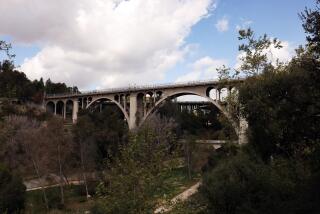Search for Promised Land
- Share via
The Quaker founders of Whittier had long since decided what to call their dream colony on the Pacific Coast, before they ventured out to look for it. They were set on naming it Whittier as a tribute to New England’s Quaker poet, John Greenleaf Whittier.
Acquilla H. Pickering and his wife, Hannah, were sent ahead from Chicago to scout for appropriate sites for their promised land, and the pair dutifully traveled beyond Sacramento to the north and as far south as Ensenada in Lower California. They searched for three long months.
One day, while in the Southland, the Pickerings were taken on a drive through East Los Angeles, out to the wide mesa, across the Rio Hondo and San Gabriel rivers and on toward the high ground where a row of pepper trees marked the ranch of John M. Thomas which, at that time, was up for sale.
From that location the Pickerings could see the whole valley and even the distant ocean. They were delighted and decided that a council of Southern California Friends should be called together at once.
The purchase of the Thomas Ranch was effected through the Pickering Land & Water Co., of which Jonathan Bailey was then president.
With that accomplished, Bailey and his wife, Rebecca established their home in the old ranch, and on May 11 of 1887 officially became Whittier’s first citizens. Four days later, the couple held religious services on the front porch of their home, and the bench on which the worshippers sat remains today on that same front porch of the surviving meeting house.
The original settlers of that community were quick to survey and subdivide the land, and by the end of that first month, initiated the sale of lots. Town lots were priced from $100 to $200 and five-acre lots outside the town site were offered for $1,000.
The word spread: The Quakers are coming, the Quakers are coming and, with the Boom of the Eighties in full swing in Southern California, carloads of newcomers began to arrive. Soon both Quakers and non-Quakers were vying for acreage in that community and the Quaker Colony began raising its land prices, claiming Whittier as “the coming place.”
In hindsight, it’s a far cry from the days when all of Whittier’s water came from springs in Turnbull Canyon, then dotted with Indian huts and labeled the place of wild bees. And probably very few of its residents today associate Whittier Boulevard with the New England poet or Pickering Avenue with Acquilla and Hannah, or Painter Avenue with John, the vice president of Pickering’s Land & Water Co., or Bailey Street with Jonathan and Rebecca, its first citizens.
From its initial core of citizens, Whittier has since grown to a population of 70,000 and its vast citrus industry has yielded to an equally successful crop of college graduates from Rio Hondo College and Whittier College, a Quaker institution of which Richard M. Nixon is its most famous alumnus.
More to Read
Sign up for Essential California
The most important California stories and recommendations in your inbox every morning.
You may occasionally receive promotional content from the Los Angeles Times.













